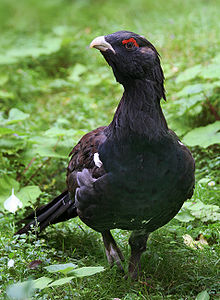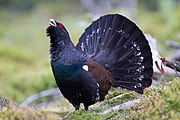Tetrao
| Tetrao Temporal range: Early Pliocene to recent
| |
|---|---|

| |
| Western capercaillie (Tetrao urogallus) | |
| Scientific classification | |
| Domain: | Eukaryota |
| Kingdom: | Animalia |
| Phylum: | Chordata |
| Class: | Aves |
| Order: | Galliformes |
| Family: | Phasianidae |
| Tribe: | Tetraonini |
| Genus: | Tetrao Linnaeus, 1758 |
| Type species | |
| Tetrao urogallus Linnaeus, 1758
| |
| Species | |
Tetrao is a genus of birds in the grouse subfamily known as capercaillies. They are some of the largest living grouse. Feathers from the bird were used to create the characteristic hat of the bersaglieri, an Italian ace infantry formation.
Taxonomy
[edit]The genus Tetrao was introduced in 1758 by the Swedish naturalist Carl Linnaeus in the tenth edition of his Systema Naturae.[1] The genus name is the Latin word for a game bird, probably a black grouse.[2] The black grouse was included by Linnaeus in the genus Tetrao but is now placed in the genus Lyrurus.[1][3] The type species was designated as the western capercaillie (Tetrao urogallus) by George Robert Gray in 1840.[4][5]
Species
[edit]The genus contains two species:[3]
| Common name | Scientific name and subspecies | Range | Size and ecology | IUCN status and estimated population |
|---|---|---|---|---|
| Western capercaillie | Tetrao urogallus Linnaeus, 1758 Eight subspecies
|
Europe to western Russia
|
Size: Habitat: Diet: |
LC
|
| Black-billed capercaillie | Tetrao urogalloides Middendorff, 1853 Two subspecies
|
eastern Russia as well as parts of northern Mongolia and China | Size: Habitat: Diet: |
LC
|
The fossil record of this genus is extensive:
- †Tetrao conjugens (Early Pliocene of C Europe)
- †Tetrao rhodopensis (Early Pliocene of Dorkovo, Bulgaria)
- †Tetrao partium (Early Pliocene - Early Pleistocene of SE Europe)
- †Tetrao macropus (Late Pliocene - Early Pleistocene of Hungary)
- †Tetrao praeurogallus (Early - Middle Pleistocene of E Europe)
References
[edit]- ^ a b Linnaeus, Carl (1758). Systema Naturae per regna tria naturae, secundum classes, ordines, genera, species, cum characteribus, differentiis, synonymis, locis (in Latin). Vol. 1 (10th ed.). Holmiae (Stockholm): Laurentii Salvii. p. 159.
- ^ Jobling, James A. (2010). The Helm Dictionary of Scientific Bird Names. London: Christopher Helm. p. 383. ISBN 978-1-4081-2501-4.
- ^ a b Gill, Frank; Donsker, David; Rasmussen, Pamela, eds. (July 2021). "Pheasants, partridges, francolins". IOC World Bird List Version 11.2. International Ornithologists' Union. Retrieved 23 August 2021.
- ^ Gray, George Robert (1840). A List of the Genera of Birds : with an Indication of the Typical Species of Each Genus. London: R. and J.E. Taylor. p. 62.
- ^ Peters, James Lee, ed. (1934). Check-List of Birds of the World. Vol. 2. Cambridge, Massachusetts: Harvard University Press. p. 24.







